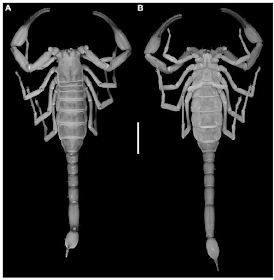Museums around world have large collections of scorpions collected in the last centuries and the specimens found in these collections are naturally important in the study of scorpion taxonomy and diversity.
Today's studies on taxonomy and phylogeny are relying more and more on molecular and genetic tools, and old museum specimens may pose a problems for these tools as they have never been preserved in the collections with these in mind.
Aaron Goodman and co-workers have recently published an article investigating the efficacy of mini-barcodes combined with longer sequences of the Cytochrome c Oxidase Subunit I (COI) gene in the systematics of scorpions. This method can be used on old, badly preserved museums specimens from complete barcodes cannot be obtained.
The results also support the recognition of nine species of the ‘thorellii’ clade, in accordance with a recent taxonomic revision published by the same authors.
Abstract:
Fragmented and degraded DNA is pervasive among museum specimens, hindering molecular phylogenetics and species identification. Mini-barcodes, 200–300-base-pair (bp) fragments of barcoding genes, have proven effective for species-level identification of specimens from which complete barcodes cannot be obtained in many groups, but have yet to be tested in arachnids. The present study investigated the efficacy of mini-barcodes combined with longer sequences of the Cytochrome c Oxidase Subunit I (COI) gene in the systematics of the arboreal Neotropical ‘thorellii’ clade of Centruroides Marx, 1890 bark scorpions (Buthidae, C.L. Koch 1837), the species of which have proven to be difficult to identify and delimit due to their similar morphology. The phylogeny of 53 terminals, representing all nine species of the clade and representative species belonging to related clades of Centruroides, rooted on Heteroctenus junceus (Herbst, 1800) and based on up to 1078 base pairs of COI and 112 morphological characters, is presented to test the monophyly of the clade and the limits of its component species. The results support the recognition of nine species of the ‘thorellii’ clade, in accordance with a recent taxonomic revision, and highlight the efficacy of mini-barcodes for identifying morphologically similar cryptic species using specimens of variable age and preservation.
Reference:
Goodman AM, Prendini L, Esposito LA. Systematics of the Arboreal Neotropical ‘thorellii’Clade of Centruroides Bark Scorpions (Buthidae) and the Efficacy of Mini-Barcodes for Museum Specimens. Diversity. 2021;13(9):441. [Open Access]




